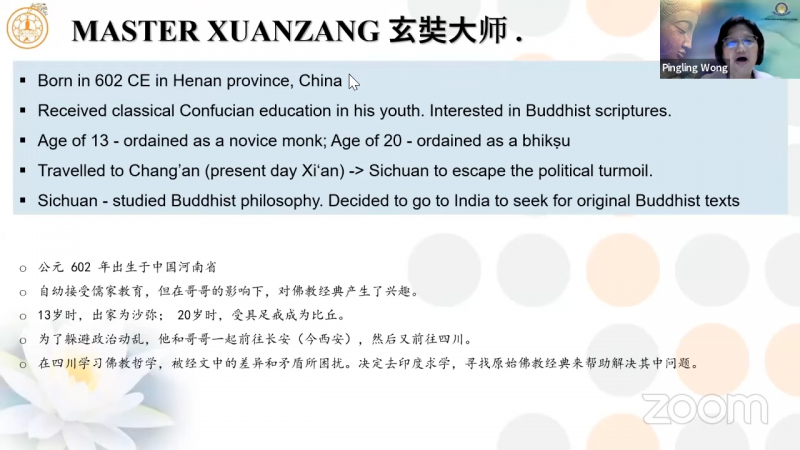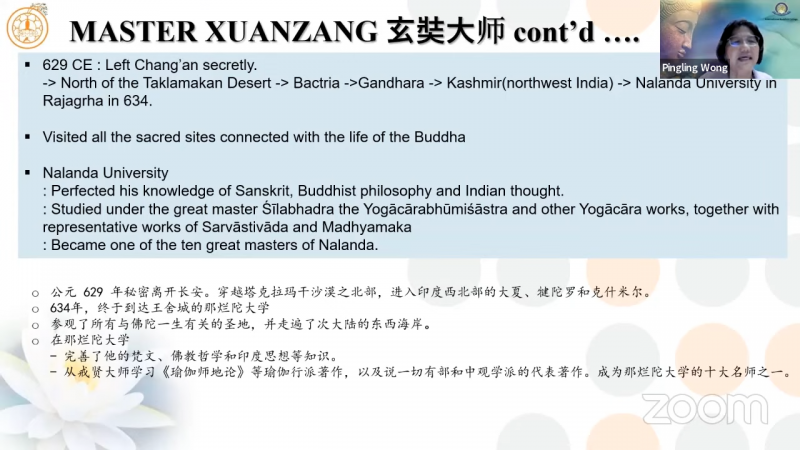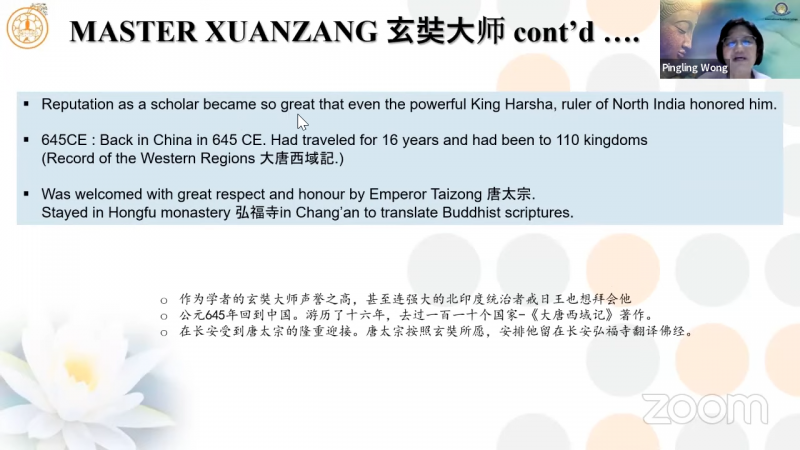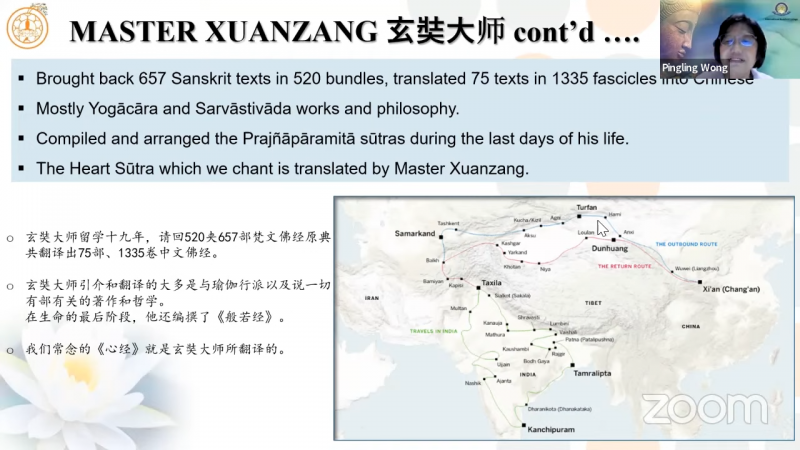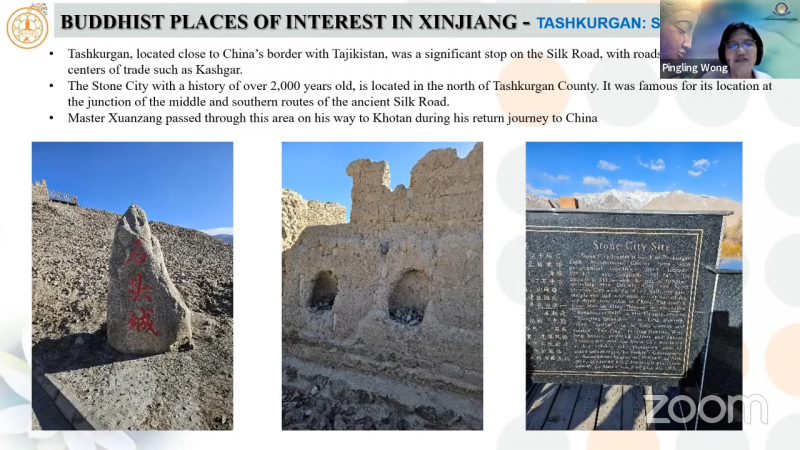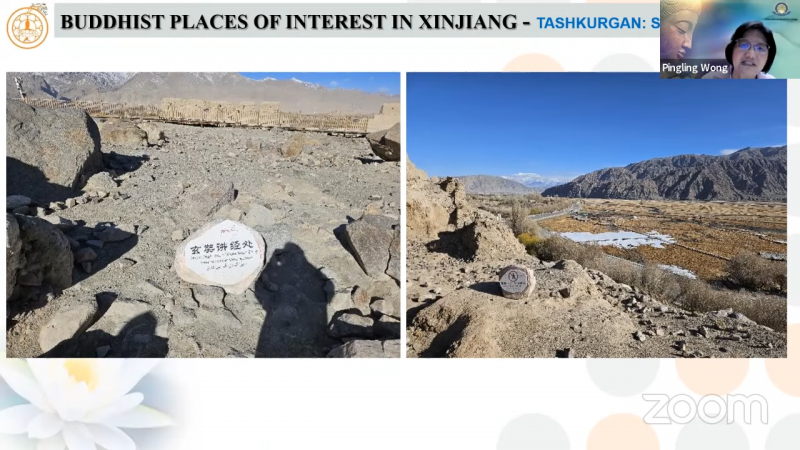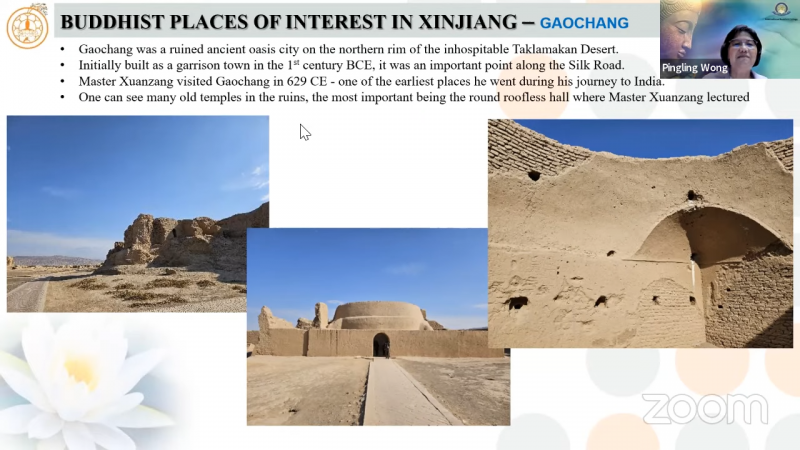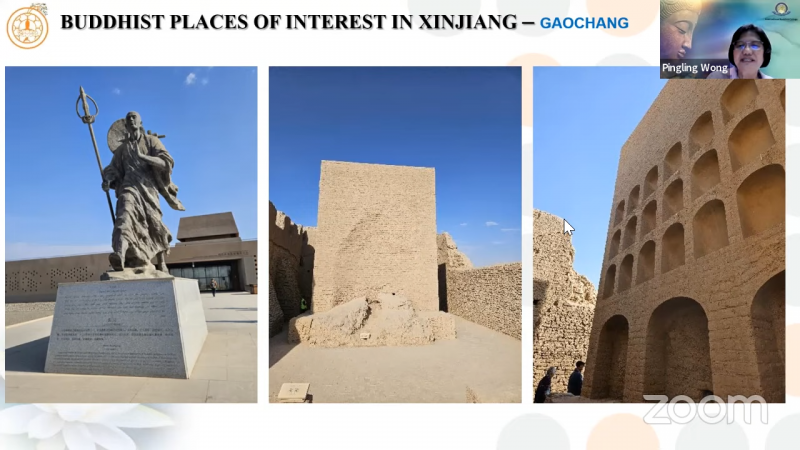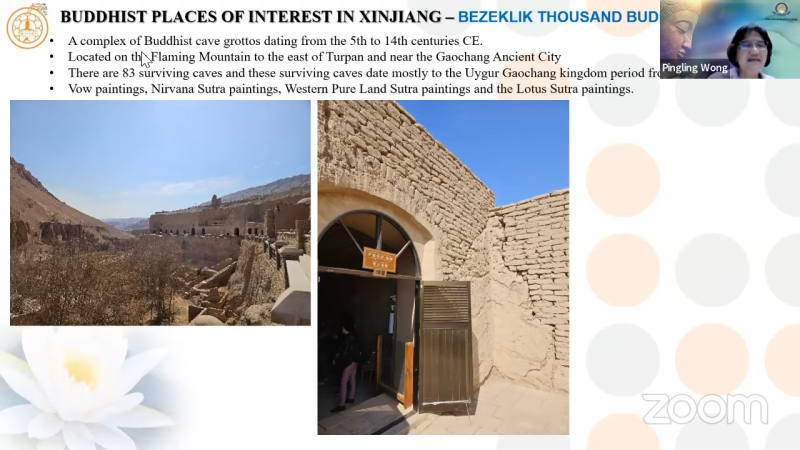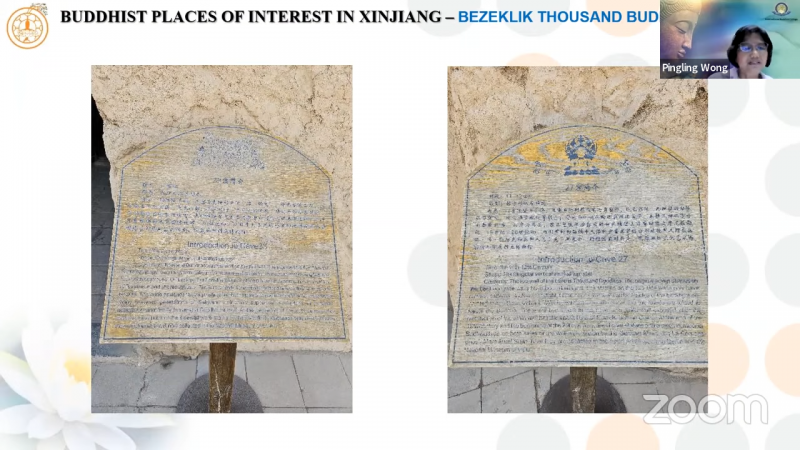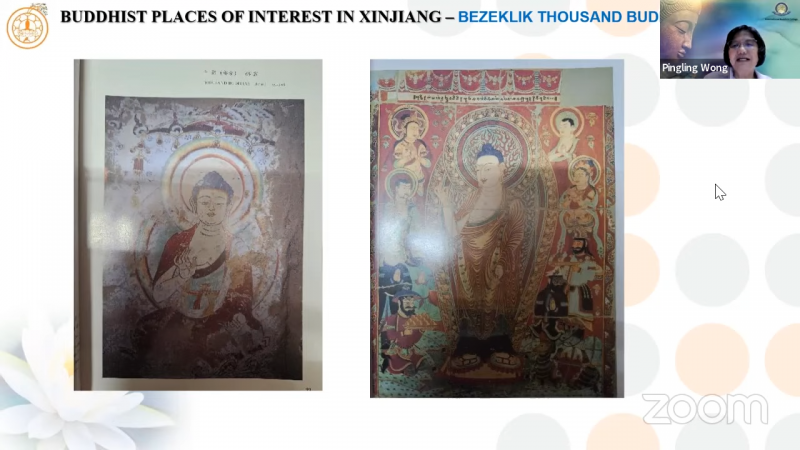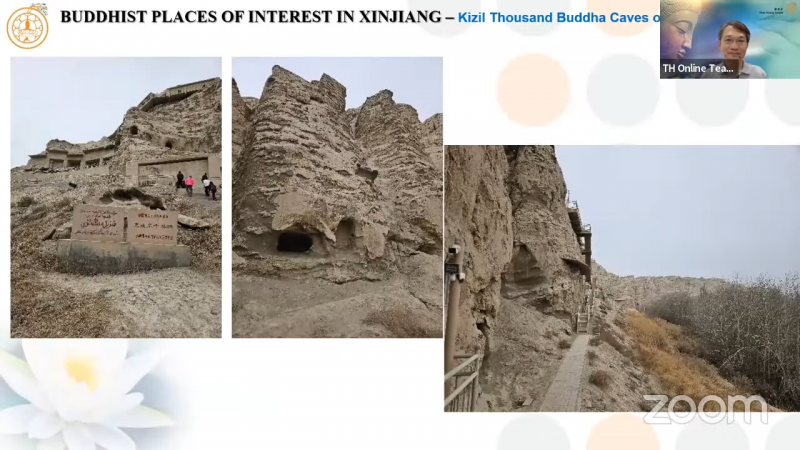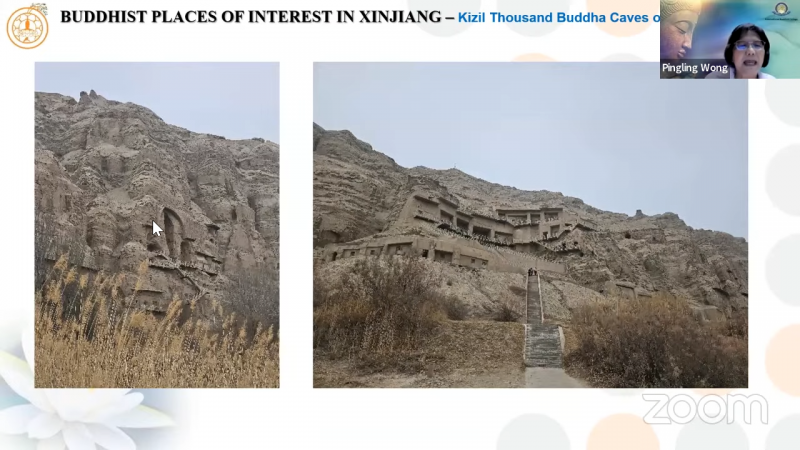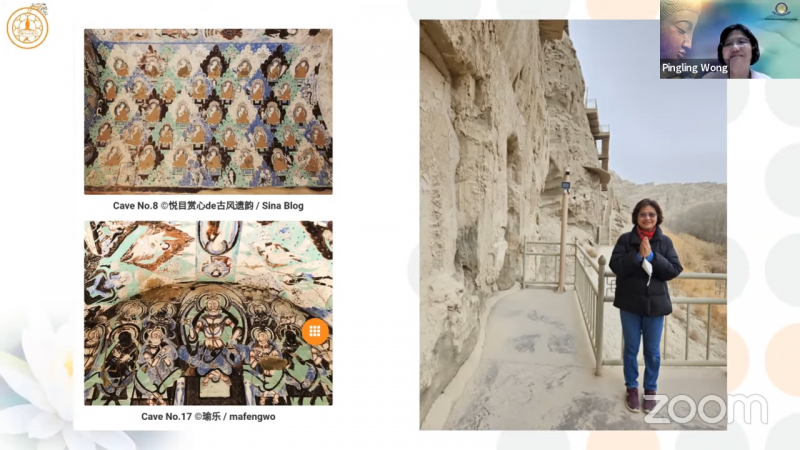Submitted by aier on

Than Hsiang's Pu Men Pin Online Gong Xiu Dharma Sharing (28/06/2024)
Teaching Assistant of IBC, Sis Wong Ping Ling sharing "Buddhist Places of Interest in Southern Xinjiang"
In March this year, Sister Wong Ping Ling went to Xin Jiang, and found the places of Buddhist Interest very interesting, so she would like to share with all of us here.
First of all, Sister Wong Ping Ling talked about the background of Xin Jiang.
Xin Jiang is officially known as the “ Xin Jiang Uygur Autonomous Region ”, and is located in the north-west of China.
Xin Jiang is spans 1.66 million sq km.
But the population is only 25.9 million. (our Malaysian population is already over 34 million. )
The reason why the population is so low is because in Xin Jiang only about 10% of the area can be inhabited by human population, because the rest consists of mountains and desert, so that is why the population compared to its land area is only 25.9 million.
Xin Jiang is the Western area of China. ( that's why in the past, it was not call Xin Jiang, is called the “Western province” ) (西域in Mandarin)
And Xin Jiang borders the countries of Mongolia, Russia, Kazakhstan, Kyrgyzstan, Tajikistan, Afghanistan, Pakistan and India.
Xin Jiang is the largest province-level division of China by area.
Why are there is many places of Buddhist significance in Xin Jiang?
Because Xin Jiang is part of the historic Silk Road which played an important role in the transmission of Buddhism to China ran through its territory. ( because it is part of the silk road)
Because the silk road passes to Xin Jiang, so that's why there are many places of significance of interesting Buddhist places significant in Xin Jiang.
Buddhism was introduced into China from central Asia from about 100 BCE by the foreign traders / merchants, but the first reliable notice of it in Chinese sources is dated 65CE.
That is the time where we have a reliable sources that the Buddhism was already introduced in China (65CE).
Subsequently, Buddhism developed in China with the translation of Indian Buddhist texts into Chinese, and one of the very famous translators of Chinese Buddhism was Master Xuan Zang. (玄奘大师)
Here, Sister Wong Ping Ling will start to talk about the Biography of Master Xuan Zang.
The reason is because 2 of the very interesting places of interest in Xin Jiang is related to Master Xuan Zang.
Actually there are the areas which Master Xuan Zang pass through during his journey to India and back.
Master Xuan Zang was Born in 602CE in He Nan province, China.
He received classical Confucian education in his youth, but he interested in Buddhist scriptures.
At the age of 13, Master Xuan Zang ordained as a novice monk, and became a full monk of Bhikṣu at the age of 20.
He was interested in a Buddhist scriptures, he travelled to Chang’An ( Chang’An 长安present day is call Xi‘An西安)
Because of there have a Political turmoil in China during that time, and later he went to Si Chuan.
And in Si Chuan, Master Xuan Zang studied Buddhist philosophy.
But he found that text existing in China at that time, there was some discrepancies.
He was confused because of this discrepancies, so and then he could not find any solution from the Chinese masters, so he decided to go to India to study and to seek for original Buddhist texts.
And in 629CE, He did not get the official permit, so he left Chang’ An secretly.
He travel North of the Taklamakan Desert.
He went to Bactria, and then to Gandhara (Gandhara is the present Afghanistan and Pakistan)
and then to Kashmir (northwest India) , and then he reached Nalanda University in Rajagrha, in India in 634CE.
Let’s look at the map, he started from Chang’An, then he went to Liang Zhou(凉州), and then he went to An’Xi(安西), Hami(哈密), Turpan, and Kucha (Aksu). All these are part of Xin Jiang, and it is called the Northern Silk Road.
So from here, he went down Afghanistan, and then he went to India.
So this is the route he went to India.
In India, Master Xuan Zang visited all the sacred sites which is connected with the life of the Buddha.
But he spend his most of his time at Nalanda University.
At Nalanda University, Master Xuan Zang perfected his knowledge of Sanskrit, Buddhist philosophy and Indian thought.
And he also studied under the great master Śīlabhadra in Nalanda University, He studied on the Yogācārabhūmiśāstra and other Yogācāra works, and also together with representative works of Sarvāstivāda and Madhyamaka.
Master Xuan Zang became one of the Ten Great Masters of Nalanda University.
Master Xuan Zang’s reputation as a scholar became so great in India that even the powerful King Harsha, The ruler of Northern India honored him.
And then he went back to china in 645CE, for that he had traveled for 16 years and had been to 110 kingdoms.
His travelled was recorded in “The Record of the Western Regions” (大唐西域記)
This he wrote his traveled under with the encouragement of The Emperor Tai Zong唐太宗of the Tang Dynasty. At that time when he came back, he was during Emperor Tai Zong’s time.
He was welcomed with great respect and honoured by Emperor Tai Zong 唐太宗.
(actually Emperor Tai Zong wanted to offer him the an official position, but he refused , and he would like to translate the Buddhist scriptures, so he stayed in Hong Fu Monastery 弘福寺in Chang’An to translate Buddhist scriptures.
When he went to India, He used what is called the Northern road of the Silk Road.
And when he came back, he used the Southern Road (Kashgar, Khotan, Dun Huang). Dun Huang is not part of Xin Jiang, Dun Huang is another province. From Dun Huang, and then back to Xi An.
Master Xuan Zang brought back 657 Sanskrit texts in 520 bundles, but he could only manage to translate 75 texts in 1335 fascicles into Chinese, mostly Yogācāra and Sarvāstivāda works and philosophy.
And during the last days of his life, Master Xuan Zang compiled and arranged the Prajñāpāramitā sūtras during the last days of his life.
“The Heart Sūtra” which we chant was translated by Master Xuan Zang.
Lets now look at this Buddhist places of interest which is connected with the Master Xuan Zang which Sister Wong Ping Ling visited in March this year.
BUDDHIST PLACES OF INTEREST IN XINJIANG - TASHKURGAN: STONE CITY 石头城
The first place which Sister Wong Ping Ling visited, which the first Buddhist place which Sister Wong Ping Ling would like to introduce is this place called Tashkurgan, specifically the Stone City which is in Tashkurgan.
Master Xuan Zang visited Tashkurgan on his way back.
If you look at the map, Tashkurgan is located close to the China’s border with Tajikistan. This is the place where in the Western North of China.
It was the significant stop on the Silk Road, with roads leading to major centers of trade such as Kashgar.
It was a significant stop on the Silk Road, located in the North of Tashkurgan, is call Stone City.
Stone City is an ancient city. It has a history of over 2,000 years old from Han Dynasty to the Qing Dynasty.
It was famous for its location at the junction of the middle and southern routes of the ancient Silk Road.
There was the junction just Master Xuan Zang passed through this area on his way to Khotan during his return journey to China.
When he go back to China, he use a Southern road.
BUDDHIST PLACES OF INTEREST IN XINJIANG – GAO CHANG 高昌
Gao Chang is actually near Turpan 吐鲁番.
This is one of the earliest places Master Xuan Zang visited during his journey to India.
Gao Chang was a ruined ancient oasis city on the northern rim of the inhospitable Taklamakan Desert.
It was initially built as a garrison town in the 1st century BCE, and it was an important point along the Silk Road.
Master Xuan Zang visited Gao Chang in 629CE.
One can see many old temples in the ruins, and the most important being the round roofless hall where Master Xuan Zang lectured.
BUDDHIST PLACES OF INTEREST IN XINJIANG – BEZEKLIK THOUSAND BUDDHA CAVE
The Bezeklik Thousand Buddha Cave, now it is a complex of Buddhist cave grottos dating from the 5th to 14th centuries CE.
It is located on the Flaming Mountain (火焰山)to the east of Turpan and near the Gao Chang Ancient City.
There are 83 surviving caves and these surviving caves date mostly to the Uygur Gao Chang kingdom period from 9th to 14th centuries.
In this caves, they used to be Vow paintings, Nirvana Sutra paintings, Western Pure Land Sutra paintings and the Lotus Sutra paintings.
BUDDHIST PLACES OF INTEREST IN XINJIANG – Kizil Thousand Buddha Caves or Kizil Grottoes
The caves are the earliest major Buddhist cave complex in China, with development occurring between the 3rd and 8th centuries CE.
A set of Buddhist rock-cut caves located near Kizil Township and to the west of Kucha.
The caves played an important role in the Silk Road transmission of Buddhism.
There are 236 cave temples in Kizil, of which 135 are relatively intact.
Murals at Kizil caves mostly depict Jataka stories and legends of the Buddha.
For more information, please browse https://youtube.com/live/CGodcqw5-j8?feature=share
Spread the Buddha's teachings to guide more people to study Buddhism.
Continue diligently in the path studying the Buddha's teachings and listening to the Dharma.
Follow us on:
https://linktr.ee/thanhsiang




